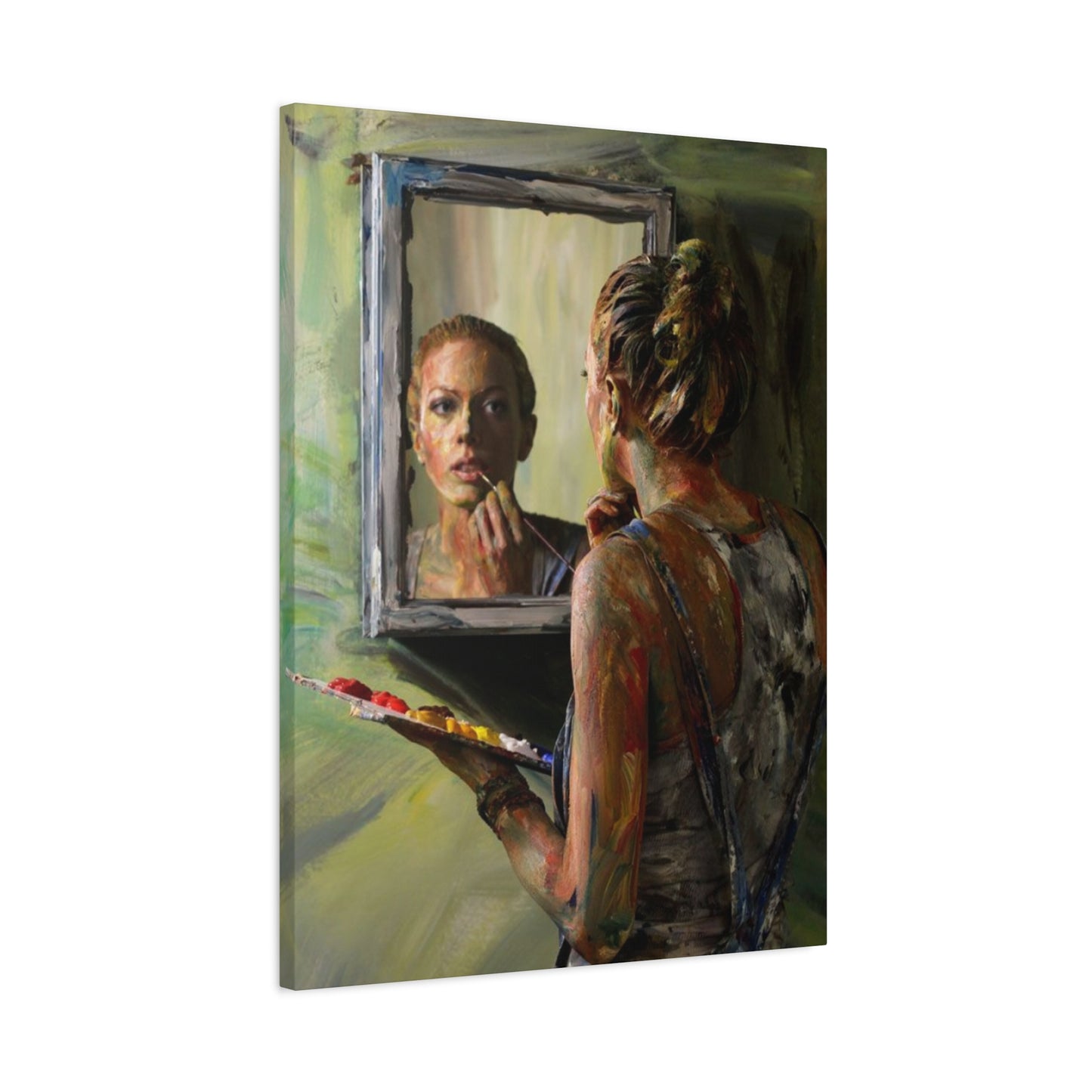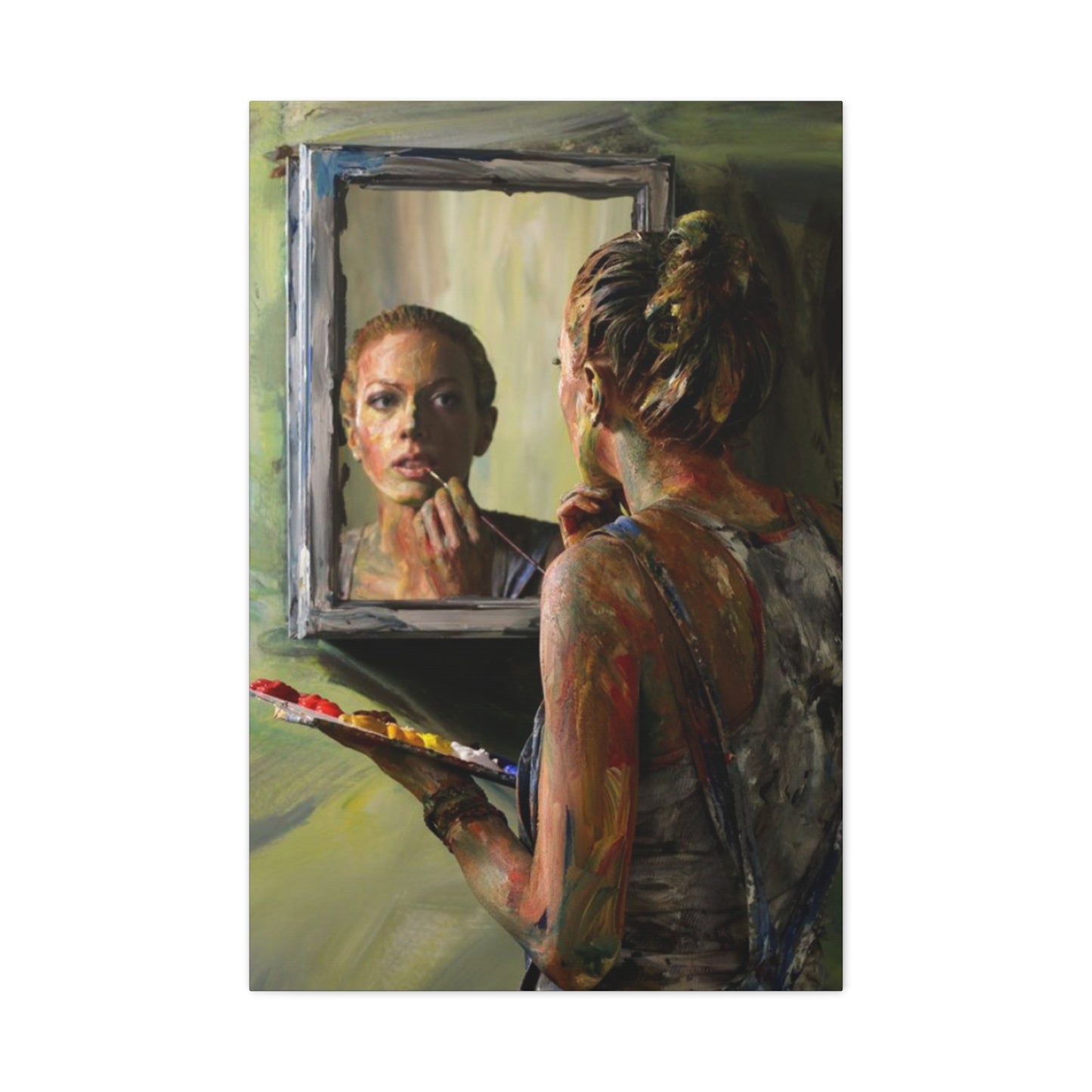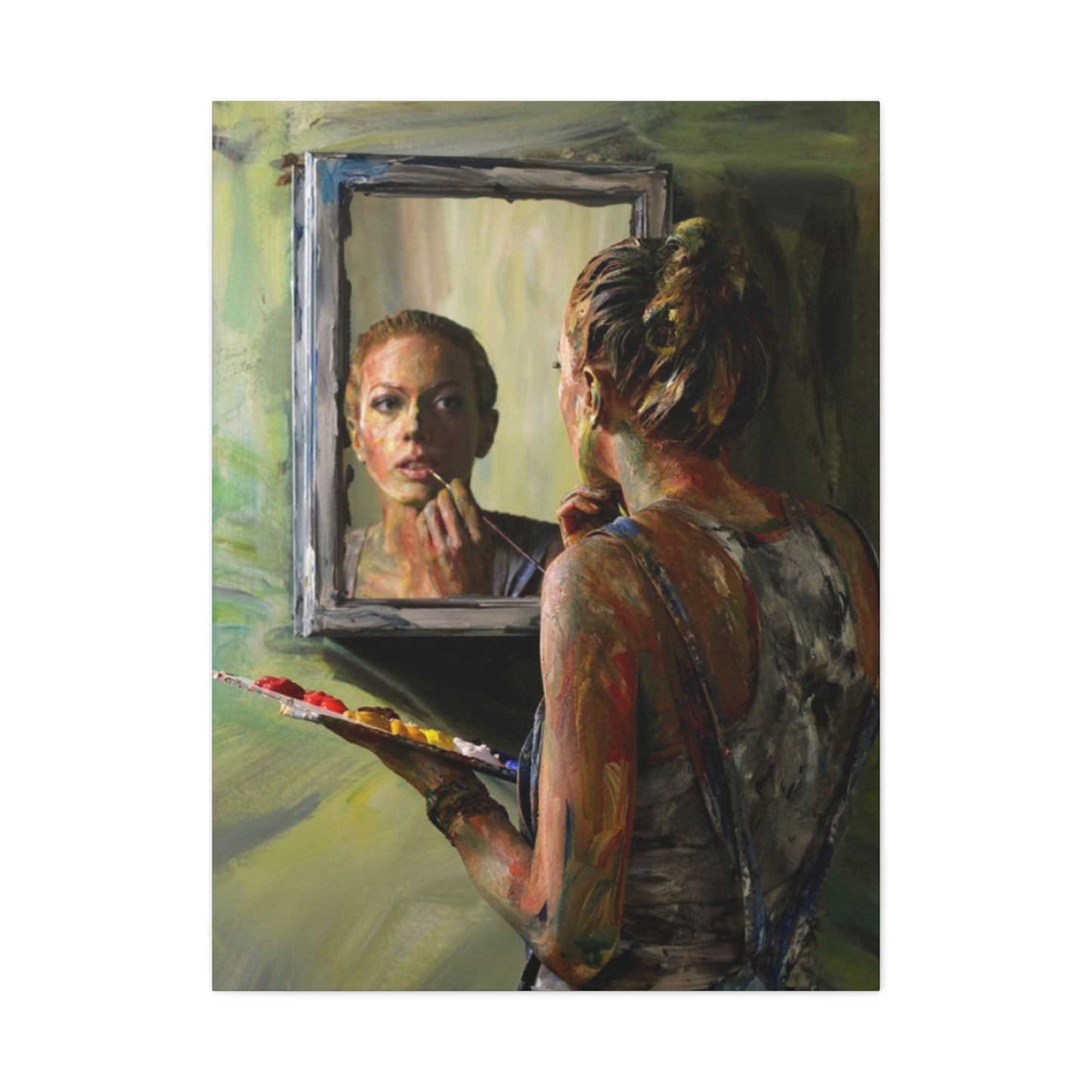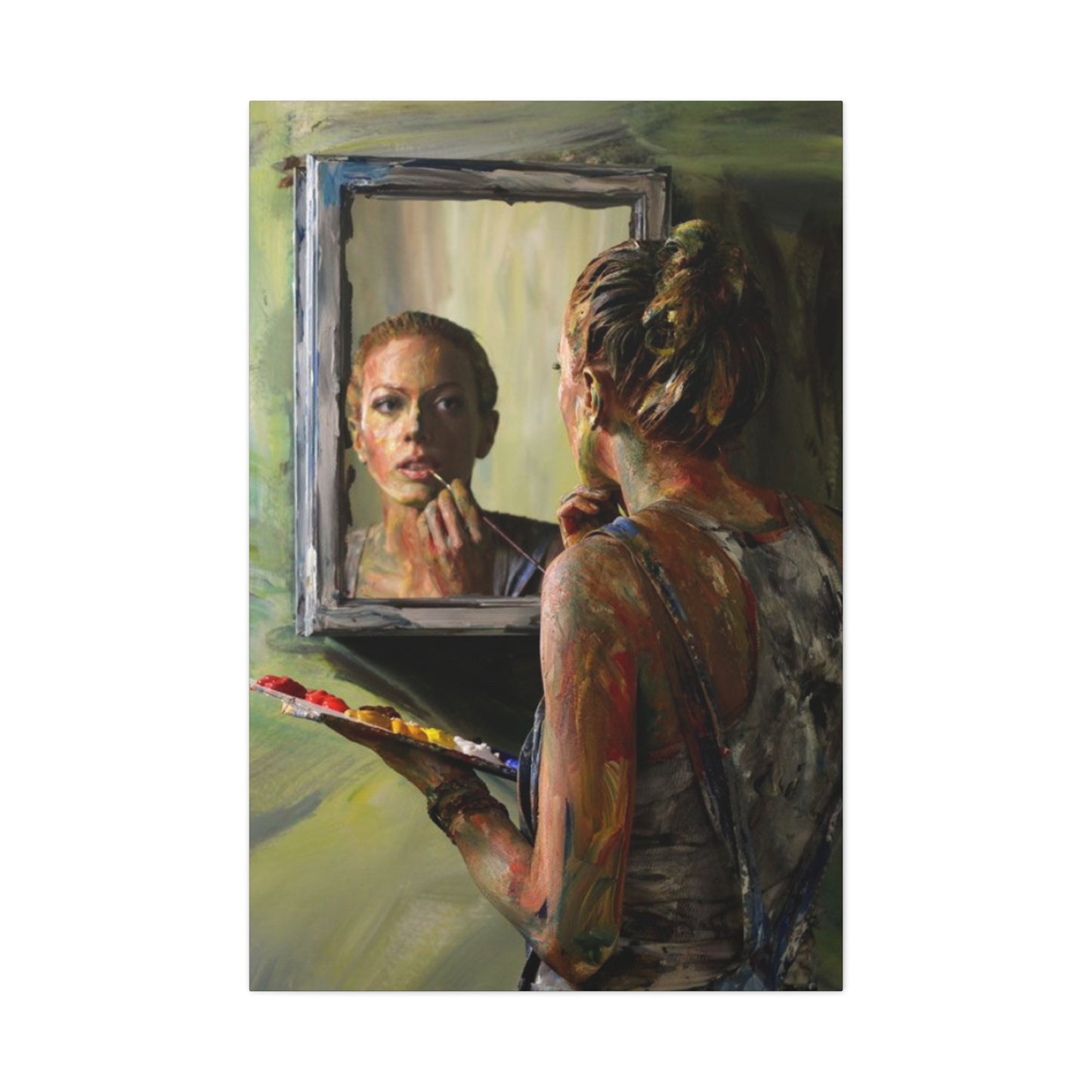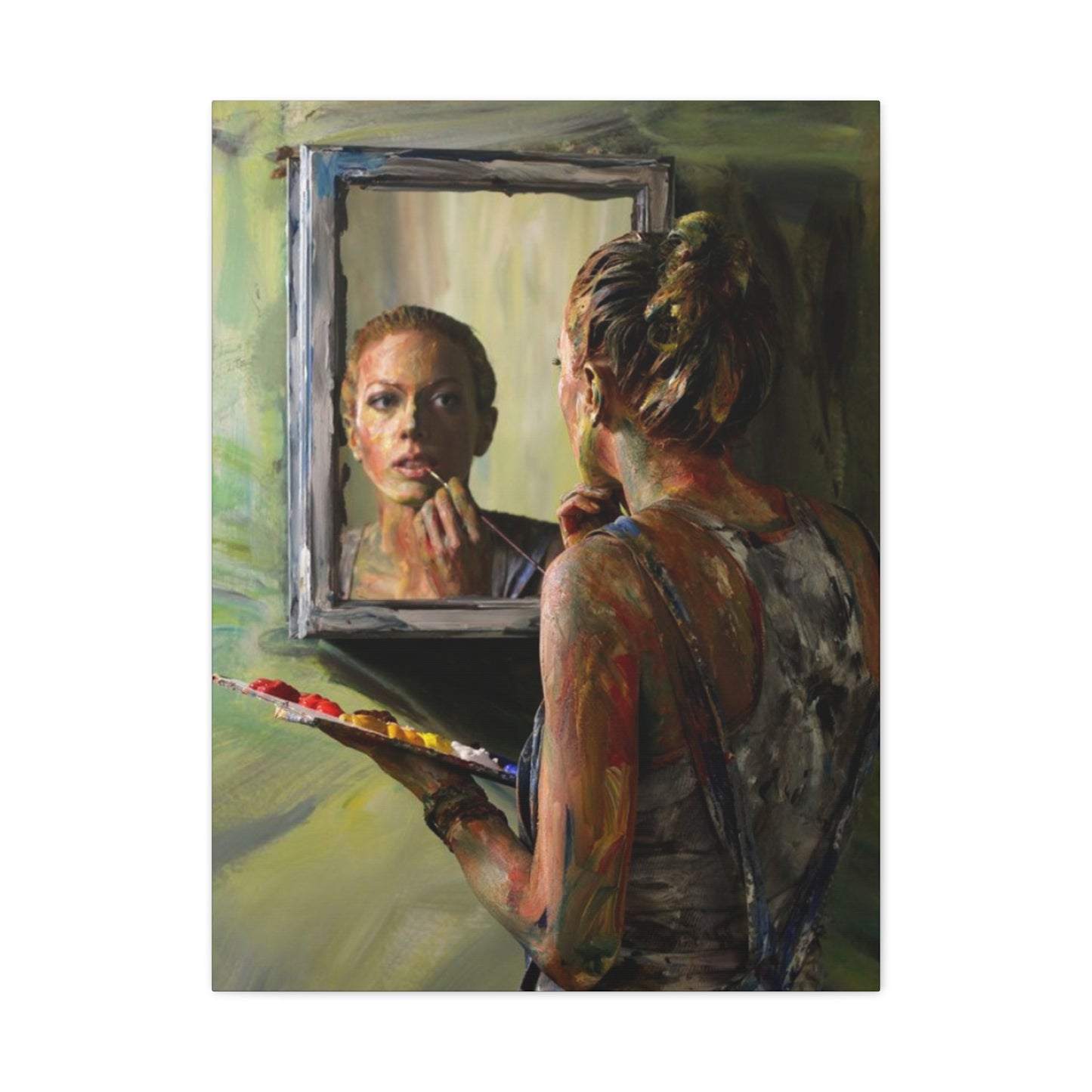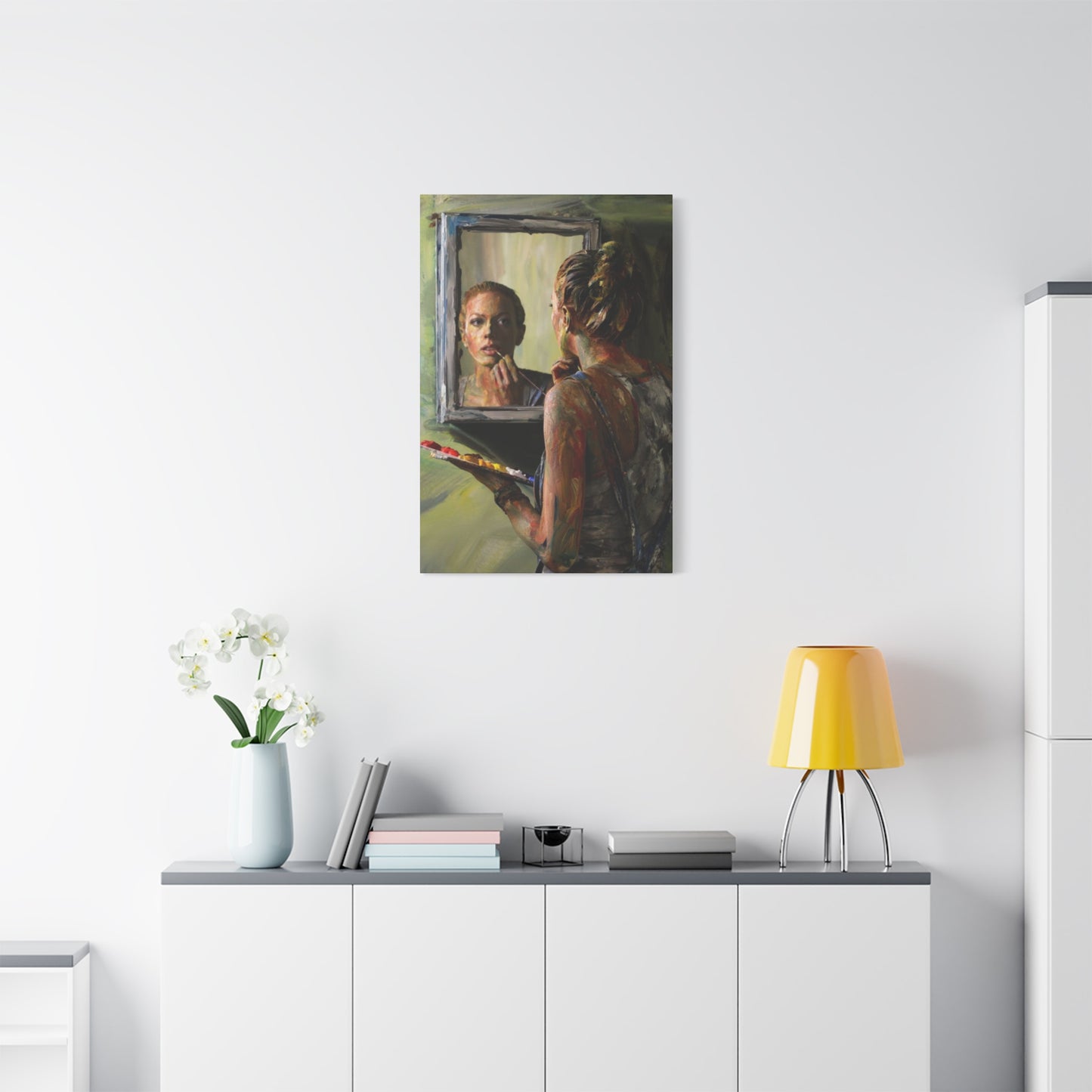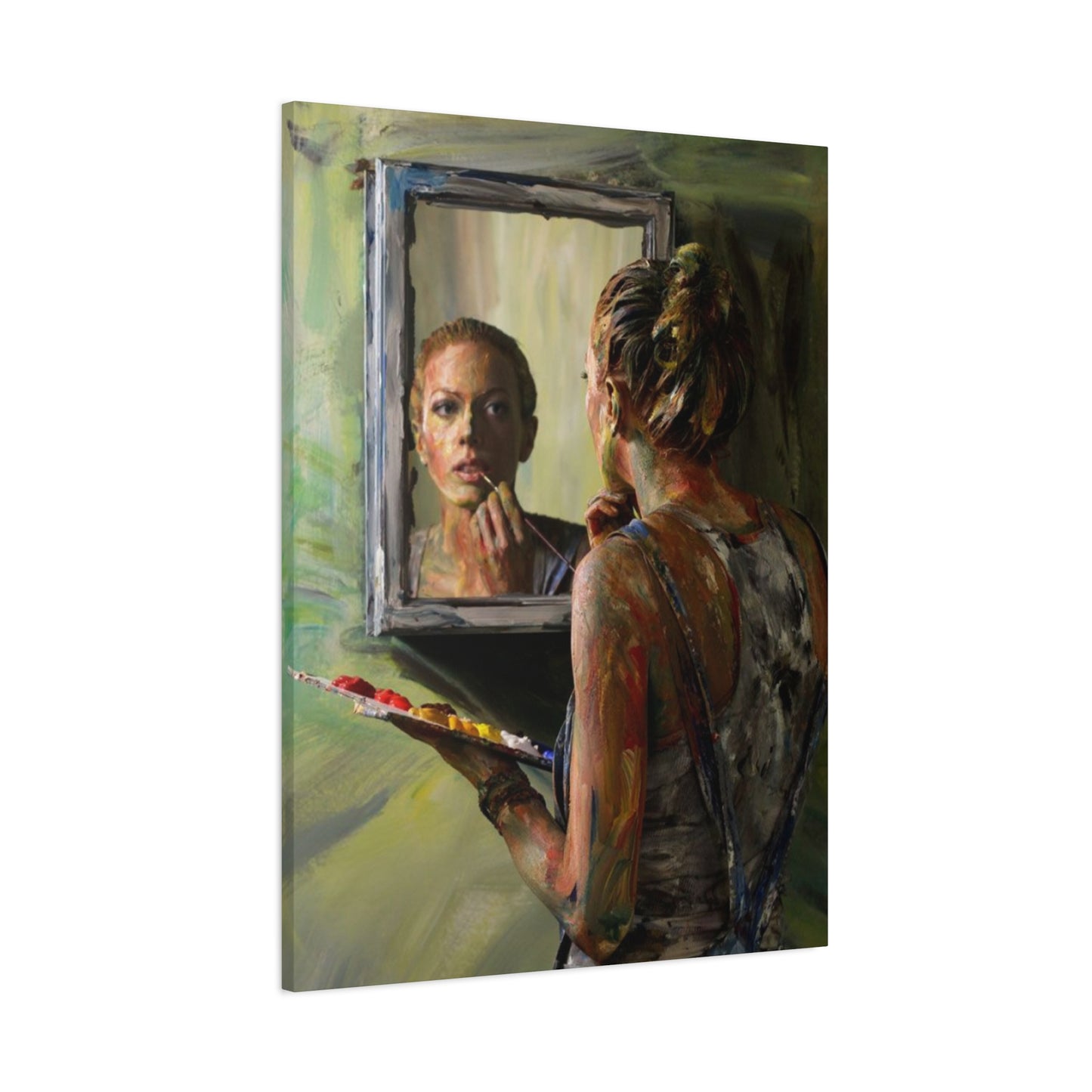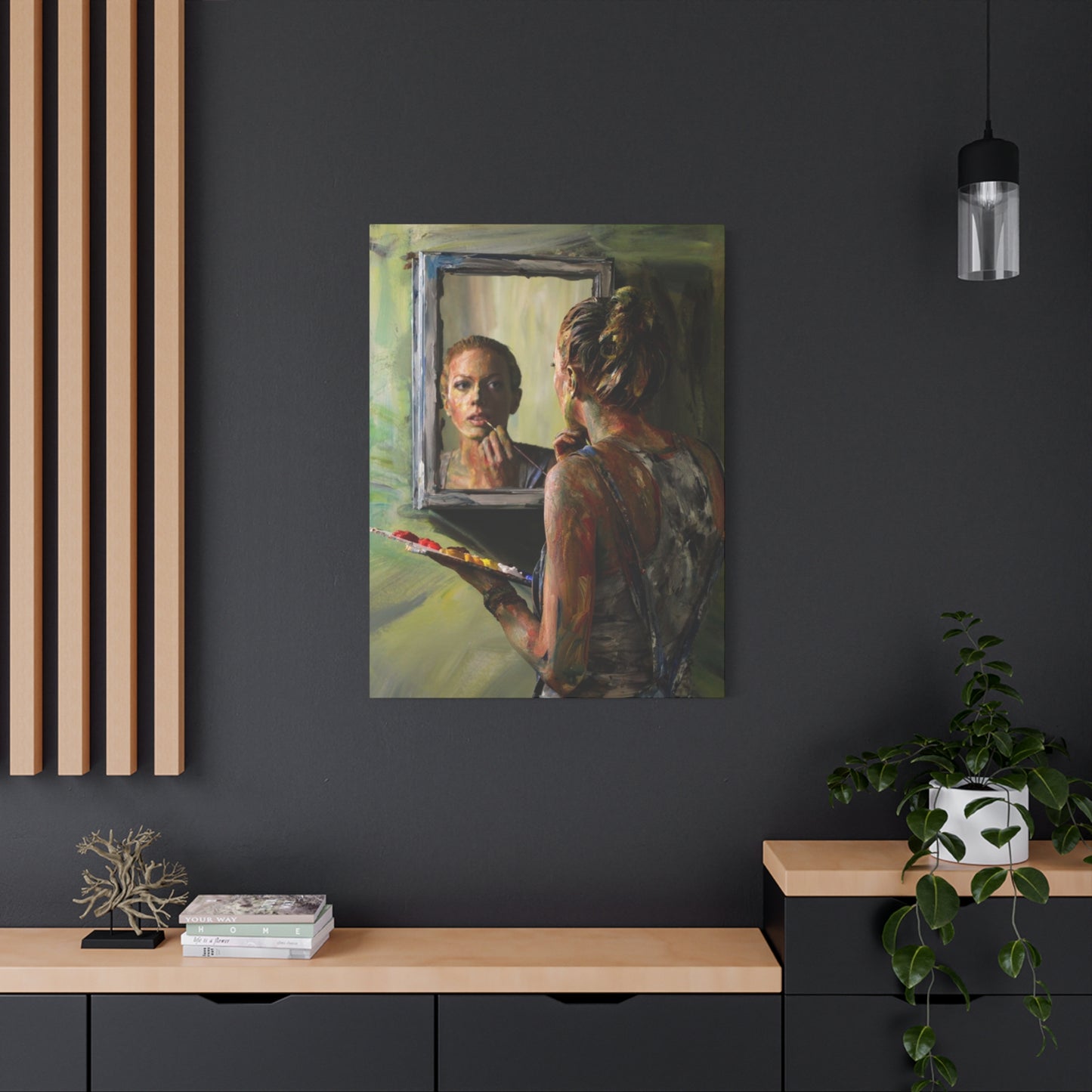Celebrate Artistic Passion with Girl Painting a Painting Mixed Media Wall Art
Canvas painting has undergone remarkable transformation throughout history, evolving from traditional oil paintings to contemporary mixed media masterpieces that grace modern homes and galleries. The journey of canvas art represents not merely a medium of expression but a cultural phenomenon that bridges classical techniques with innovative approaches. Artists today embrace both time-honored methods and cutting-edge materials to create stunning visual narratives that captivate viewers and enhance living environments.
The contemporary canvas painting movement encompasses diverse styles, from photorealistic portraits to abstract compositions that challenge conventional artistic boundaries. Artists working with canvas explore themes ranging from personal identity to social commentary, utilizing various pigments, textures, and layering techniques to achieve desired visual effects. This artistic evolution reflects changing societal values and technological advancements that have expanded creative possibilities.
Modern canvas art creation involves careful consideration of surface preparation, paint selection, and compositional elements that contribute to the overall impact of the finished piece. Artists must understand how different materials interact with canvas fibers and how environmental factors affect paint adhesion and longevity. The technical aspects of canvas painting require mastery of fundamental skills while encouraging experimental approaches that push creative boundaries.
The commercial art market has embraced canvas paintings as valuable investments and decorative elements, creating opportunities for emerging artists to showcase their talents through various platforms. Gallery exhibitions, online marketplaces, and art fairs provide venues for artists to connect with collectors and art enthusiasts who appreciate handcrafted visual expressions. This growing market demand has stimulated innovation in canvas painting techniques and presentation methods.
The Magic of Mixed Media
Mixed media art is a captivating fusion of various materials and techniques that come together to create a truly multidimensional experience. Unlike traditional painting, which often relies on a single medium, mixed media art invites artists to blend acrylic paints with collage elements, ink sketches, textured fabrics, and even found objects. This combination creates a rich tapestry of visual and tactile layers, each telling its own part of the story.
What makes mixed media especially magical is its invitation to experimentation and play. Artists can push the boundaries of conventional art by layering materials in unexpected ways—gluing scraps of paper or fabric to add texture, splattering ink to evoke spontaneity, or using palette knives to carve into thick paint layers. These techniques allow artists to build depth not just physically on the canvas but emotionally within the work, engaging viewers on multiple levels.
Because no two mixed media pieces are ever the same, this art form celebrates individuality and innovation. It encourages artists to explore contrasts—smooth versus rough, bright versus muted, controlled versus chaotic—and to weave these contrasts into harmonious compositions. The resulting artwork becomes more than a picture; it becomes a vibrant storybook where every element has meaning, inviting viewers to look closer and discover hidden details.
The Girl and Her Artistic Journey
Picture a young girl standing before a sprawling canvas, her hands covered in dabs of paint, surrounded by an eclectic collection of art supplies—pots of shimmering acrylics, torn scraps of colorful paper, brushes of all sizes, charcoal sticks, and bottles of ink. Her gaze is intense and full of wonder, reflecting both curiosity and a quiet confidence.
With each brushstroke, she explores the interplay of colors—bold reds blending into soft blues, jagged shapes overlapping gentle curves. As she layers torn paper and textured fabrics onto the canvas, she experiments fearlessly, unafraid to mix different materials and create surprising effects. Her artwork grows organically, evolving from mere shapes and colors into a vivid narrative that captures her thoughts, emotions, and dreams.
Her creative process is more than just making art; it’s a profound journey of self-discovery. She learns resilience by patiently layering and sometimes scraping away parts of her work to reveal new possibilities beneath. She experiences joy in the spontaneous drips of paint and the unexpected textures that emerge. Above all, she celebrates the freedom to express herself without constraints, blending chaos and harmony to create something uniquely hers.
Wall Art that Transforms Spaces
Mixed media wall art, like the one crafted by this young artist, holds the remarkable power to transform any space it inhabits. Unlike flat, traditional paintings that may serve as simple decoration, mixed media pieces add palpable depth and character, engaging the room on a sensory level. The textures invite touch, the layers invite exploration, and the colors invite emotion.
When hung on a wall, such art becomes an immersive experience—almost a living presence that shifts and changes depending on the light and the viewer’s perspective. It breathes personality into the room, turning a blank wall into a vibrant storytelling canvas. Whether in a home, a classroom, or a gallery, mixed media wall art creates an atmosphere charged with creativity and inspiration.
Moreover, these artworks invite viewers to pause and connect. Each layer reveals something new—be it a hidden piece of collage, a brushstroke that suggests movement, or an ink line that evokes emotion. The viewer is drawn in, encouraged to interpret and relate to the story woven through the textures and colors.
In this way, the girl’s mixed media wall art is more than just a painting; it’s a transformative presence, a celebration of youthful passion that enriches any space it adorns.
Exploring Mixed Media Techniques for Dynamic Artistic Results
Mixed media art represents a revolutionary approach to creative expression that combines traditional painting methods with unconventional materials and techniques. Artists working in mixed media push beyond the limitations of single-medium artwork, incorporating elements such as paper collages, fabric textures, metallic accents, and three-dimensional objects into their canvas compositions. This artistic approach creates layered visual experiences that engage viewers on multiple sensory levels.
The versatility of mixed media techniques allows artists to experiment with contrasting textures, colors, and materials that would be impossible to achieve through traditional painting alone. By incorporating materials like sand, coffee grounds, newspaper clippings, or fabric scraps, artists create unique surface qualities that add depth and interest to their compositions. These varied textures catch light differently, creating dynamic visual effects that change based on viewing angles and lighting conditions.
Professional mixed media artists often develop signature techniques that become recognizable elements of their artistic style. Some artists specialize in combining photographic elements with painted sections, while others focus on incorporating natural materials like leaves, shells, or stones into their canvas works. The key to successful mixed media art lies in achieving harmony between disparate elements while maintaining overall compositional coherence.
The technical challenges of mixed media art require artists to understand how different materials age and interact over time. Proper preparation and sealing techniques ensure that mixed media pieces maintain their visual integrity and structural stability. Artists must consider factors such as material compatibility, adhesion properties, and environmental stability when selecting components for their mixed media compositions.
Canvas Print Production Methods and Quality Considerations
Canvas print production has revolutionized how artwork reaches consumers, offering affordable alternatives to original paintings while maintaining high visual quality. Modern printing technologies enable accurate reproduction of original artworks on canvas substrates, creating pieces that closely resemble hand-painted originals. The canvas print industry has developed sophisticated processes that ensure color accuracy, detail reproduction, and longevity.
Digital printing technologies used for canvas production include inkjet systems that utilize archival-quality inks specifically formulated for textile substrates. These specialized inks resist fading, moisture damage, and color shifting over extended periods, ensuring that canvas prints maintain their visual appeal for decades. Professional canvas printing facilities employ color management systems that accurately reproduce the subtle color variations and tonal ranges present in original artworks.
The selection of canvas materials significantly impacts the final quality of printed reproductions. Premium canvas substrates feature consistent weave patterns, appropriate surface textures, and chemical compositions that interact favorably with printing inks. Cotton canvas offers excellent ink absorption and durability, while synthetic blends provide enhanced dimensional stability and resistance to environmental factors.
Post-printing processes such as protective coating application and proper stretching techniques contribute to the professional appearance and longevity of canvas prints. UV-resistant topcoats shield printed surfaces from light-induced fading, while proper stretching ensures that canvas prints maintain their shape and tension over time. Professional framing and mounting techniques further enhance the presentation quality of canvas prints.
Essential Art Supplies and Materials for Canvas Creation
The foundation of exceptional canvas artwork begins with selecting appropriate materials and supplies that support artistic vision while ensuring longevity. Professional-grade canvases offer superior painting surfaces with consistent texture and proper priming that enhances paint adhesion and color vibrancy. Artists must consider factors such as canvas weight, weave density, and priming quality when selecting substrates for their creative projects.
Acrylic paints have gained popularity among contemporary artists due to their versatility, quick drying times, and extensive color ranges. High-quality acrylic formulations offer excellent lightfastness ratings, ensuring that finished artworks maintain their color integrity over time. Artists working with acrylics can manipulate paint consistency through the addition of mediums that alter drying times, texture, and finish characteristics.
Oil paints continue to be favored by many professional artists for their exceptional blending properties and extended working times. Traditional oil painting techniques allow for subtle color transitions and detailed rendering that remain challenging to achieve with other mediums. However, oil paints require proper ventilation and extended drying periods that must be considered in project planning.
Brush selection plays a crucial role in achieving desired artistic effects and maintaining efficient workflow. Different brush shapes and bristle types produce distinct mark-making qualities that contribute to overall artistic style. Synthetic brushes offer consistency and easy maintenance, while natural bristle brushes provide unique textural qualities that some artists prefer for specific techniques.
Color Theory and Palette Development for Impactful Artwork
Understanding color theory principles enables artists to create harmonious compositions that effectively communicate intended moods and messages. The color wheel serves as a fundamental tool for understanding relationships between hues and developing effective color schemes. Artists who master color theory can manipulate viewer emotions and direct attention through strategic color placement and contrast.
Primary colors form the foundation of all color mixing, while secondary and tertiary colors expand the available palette range. Warm colors tend to advance visually and create energetic feelings, while cool colors recede and promote calm sensations. Artists can exploit these psychological color associations to enhance the emotional impact of their artworks.
Color temperature relationships significantly impact the overall atmosphere of painted compositions. Warm undertones create inviting, energetic environments, while cool undertones suggest tranquility and sophistication. Professional artists often develop limited palettes that maintain color harmony while providing sufficient range for complete artistic expression.
Value relationships between colors determine the overall contrast and visual hierarchy within compositions. High-value contrast creates dramatic focal points, while subtle value transitions promote gentle visual flow. Artists must balance color intensity with value relationships to achieve desired visual effects without creating jarring or unpleasant combinations.
Composition Techniques for Engaging Visual Narratives
Effective composition forms the backbone of compelling artwork that captures and maintains viewer attention. The rule of thirds provides a fundamental framework for positioning key elements within the picture plane, creating natural focal points that guide viewer engagement. Professional artists understand that strong compositions often violate traditional rules while maintaining underlying principles that ensure visual coherence.
Leading lines direct viewer attention through the composition and can be created through various means, including brushstrokes, color transitions, and value changes. These invisible pathways help viewers navigate complex compositions and discover important details that contribute to overall artistic meaning. Strategic use of leading lines can create dynamic movement or peaceful stability, depending on artistic intent.
Balance within compositions can be achieved through symmetrical or asymmetrical arrangements of visual elements. Symmetrical balance creates formal, stable compositions, while asymmetrical balance generates more dynamic and interesting visual relationships. Artists must consider the visual weight of different elements, including color intensity, size, and complexity, when creating balanced compositions.
Negative areas play equally important roles in successful compositions by providing visual rest areas and emphasizing positive elements. Strategic use of negative areas can create powerful silhouettes, suggest depth, and prevent compositions from becoming visually overwhelming. Understanding the relationship between positive and negative areas enables artists to create more sophisticated and engaging artworks.
Texture Creation Methods for Enhanced Visual Interest
Texture adds tactile qualities to painted surfaces that engage viewers beyond purely visual appreciation. Artists employ various techniques to create texture, from impasto applications that build paint layers to subtle glazing methods that suggest surface variations. Understanding different texture creation methods enables artists to develop signature styles and enhance the sensory appeal of their artworks.
Impasto techniques involve applying paint in thick layers that retain brush or palette knife marks, creating dimensional surface qualities that interact dramatically with light. This approach works particularly well for creating the impression of fabric, foliage, or rough natural surfaces. Artists using impasto techniques must consider paint drying times and potential cracking that can occur with extremely thick applications.
Dry brush techniques create subtle texture effects by applying paint with minimal medium, allowing underlying surface texture to show through. This method works effectively for suggesting aged surfaces, natural materials, or atmospheric effects. Dry brush applications require careful paint consistency and brush control to achieve desired results without overworking painted surfaces.
Glazing techniques involve applying transparent or semi-transparent paint layers over existing painted surfaces, creating depth and optical color mixing effects. Successful glazing requires understanding paint transparency properties and proper medium ratios to achieve smooth, even applications. Multiple glaze layers can create complex color variations and luminous surface qualities.
Portrait Painting Fundamentals for Character Development
Portrait painting challenges artists to capture not only physical likeness but also psychological presence and personality characteristics. Successful portraits require careful observation of proportional relationships, surface anatomy, and subtle expression details that reveal individual character. Artists must develop skills in rendering various skin tones, hair textures, and facial features while maintaining overall compositional unity.
Facial proportion understanding forms the foundation of convincing portrait work. The basic head proportions provide guidelines for feature placement, though individual variations require careful observation and adjustment. Artists must learn to see beyond superficial details to understand underlying structural relationships that define facial character.
Skin tone rendering requires sophisticated color mixing skills and understanding of how light affects surface appearance. Different ethnicities present unique color challenges that demand sensitivity and careful observation. Artists must avoid stereotypical color assumptions and instead focus on individual characteristics that create authentic representations.
Eye rendering often determines the success of portrait paintings, as eyes serve as primary communication points between artwork and viewer. Understanding eye anatomy, light reflection patterns, and expression subtleties enables artists to create compelling portraits that engage viewers emotionally. Proper eye rendering requires attention to both technical accuracy and expressive qualities.
Landscape Painting Techniques for Natural Beauty Capture
Landscape painting connects artists with natural environments while challenging them to translate three-dimensional experiences onto two-dimensional surfaces. Successful landscape artists develop skills in atmospheric perspective, color temperature relationships, and compositional techniques that effectively convey outdoor experiences. Understanding natural lighting conditions and their effects on color and form enables artists to create convincing landscape representations.
Atmospheric perspective creates the illusion of depth through color and value changes that occur over distance. Distant elements appear cooler, lighter, and less detailed than foreground elements, following natural atmospheric effects. Artists can manipulate these relationships to enhance spatial depth and create compelling landscape compositions.
Sky rendering often sets the overall mood and lighting conditions for landscape paintings. Cloud formations, color gradations, and light direction significantly impact the entire composition. Artists must observe how sky conditions affect landscape elements and adjust their color relationships accordingly to maintain visual coherence.
Foreground detail balance requires careful consideration to avoid overwhelming compositions while maintaining visual interest. Strategic detail placement can guide viewers through landscape compositions and create focal points that anchor the overall design. Understanding which details to include and which to simplify distinguishes professional landscape work from amateur attempts.
Abstract Art Creation and Emotional Expression
Abstract art liberates artists from representational constraints, enabling pure exploration of color, form, and composition relationships. Successful abstract work requires strong design sensibilities and understanding of how visual elements interact to create emotional responses. Artists working abstractly must develop personal visual vocabularies that communicate their artistic intentions effectively.
Color relationships in abstract work carry primary responsibility for emotional communication, as viewers cannot rely on recognizable subject matter for meaning. Bold color contrasts create energetic, dynamic compositions, while subtle color harmonies suggest contemplative or peaceful moods. Abstract artists must understand color psychology to effectively convey intended emotions.
Compositional flow in abstract work guides viewer attention through non-representational elements such as line, shape, and color transitions. Creating visual pathways through abstract compositions requires understanding of design principles and how various elements can work together to create unified artistic statements.
Mark-making techniques in abstract art become significant compositional elements that contribute to overall artistic meaning. Different brushstrokes, application methods, and tool choices create unique visual signatures that distinguish individual artistic styles. Developing personal mark-making vocabularies enables abstract artists to create recognizable and meaningful work.
Still Life Painting for Technical Skill Development
Still life painting provides controlled environments for developing fundamental artistic skills while exploring lighting, composition, and rendering techniques. Artists can manipulate lighting conditions, object arrangements, and color relationships to create ideal learning situations. Still life work builds technical confidence that transfers to more complex subject matter.
Object selection for still life arrangements requires consideration of form, texture, color, and symbolic meaning. Combining objects with contrasting characteristics creates visual interest while providing varied technical challenges. Simple arrangements often prove more effective than complex groupings that can become visually confusing.
Lighting control in still life work enables artists to study how light affects form, color, and texture. Single light sources create dramatic effects with strong shadows and highlights, while multiple light sources provide more even illumination that reveals subtle surface qualities. Understanding lighting effects enhances all other painting disciplines.
Surface texture rendering in still life work provides opportunities to practice various painting techniques within single compositions. Artists can explore how different materials reflect light and interact with surrounding elements. Developing texture rendering skills through still life practice improves overall painting abilities.
Figure Drawing and Human Form Representation
Figure drawing challenges artists to understand human anatomy, proportion, and movement while developing observational skills essential for all representational art. Working from live models provides invaluable experience in capturing gesture, expression, and individual characteristics that distinguish exceptional figure work from generic representations.
Anatomical understanding forms the foundation of convincing figure drawing, enabling artists to render human forms accurately regardless of pose or viewing angle. Knowledge of skeletal structure, muscle groups, and surface anatomy helps artists understand why forms appear as they do and how movement affects overall appearance.
Gesture capture requires quick observation and decisive mark-making that captures essential movement qualities rather than detailed surface information. Successful gesture drawings communicate energy, weight distribution, and personality through economical means. Developing gesture skills improves all other aspects of figure work.
Proportion relationships in figure drawing follow general guidelines while requiring individual adjustments based on model characteristics. Understanding basic proportional relationships provides starting points for accurate figure construction, while careful observation reveals individual variations that create authentic representations.
Digital Art Integration with Traditional Techniques
Contemporary artists increasingly combine digital tools with traditional techniques to expand creative possibilities and streamline workflow processes. Digital technologies enable artists to experiment with compositions, test color relationships, and create preliminary studies without consuming traditional materials. Understanding how digital and traditional approaches complement each other opens new creative avenues.
Photographic reference gathering has been revolutionized by digital cameras and editing software that enable artists to capture and manipulate reference materials efficiently. High-quality digital images provide detailed information about lighting, color relationships, and structural details that support traditional painting processes.
Color matching between digital and physical mediums requires understanding how different display systems affect color appearance. Monitor calibration and color management systems help ensure that digital color studies translate accurately to traditional painted surfaces. Artists must account for differences between transmitted and reflected light when working between digital and traditional mediums.
Hybrid workflow processes combine digital planning with traditional execution to maximize the strengths of both approaches. Artists can develop compositions digitally, test color relationships, and create detailed plans before committing to traditional materials. This approach reduces waste while enabling more experimental approaches to traditional techniques.
Art Business and Marketing Strategies for Success
Professional artists must develop business skills alongside artistic abilities to achieve sustainable careers in competitive art markets. Understanding pricing strategies, marketing techniques, and client relationship management determines artistic success as much as creative talent. Building professional reputations requires consistent quality production and effective self-promotion.
Portfolio development showcases artistic range and quality while targeting specific market segments. Professional portfolios demonstrate technical skills, creative vision, and consistency that attract collectors, galleries, and commercial clients. Digital portfolios enable global reach while physical portfolios provide tactile experiences that some clients prefer.
Online presence development through websites, social media platforms, and digital marketplaces expands artist reach beyond local markets. Professional online presentations require high-quality photography, compelling artist statements, and consistent branding that reflects artistic identity. Regular content updates maintain audience engagement and demonstrate ongoing artistic development.
Pricing strategies must balance artistic value with market realities while ensuring sustainable income generation. Research into comparable artists' pricing, material costs, and time investments provides foundations for realistic pricing structures. Professional artists must value their work appropriately while remaining competitive within their market segments.
Art Conservation and Preservation Techniques
Proper conservation techniques ensure that painted artworks maintain their visual quality and structural integrity over extended periods. Understanding materials' aging characteristics, environmental factors, and preservation methods enables artists to create more durable work while protecting existing collections. Conservation knowledge benefits both creators and collectors.
Environmental control significantly impacts artwork longevity, with factors such as temperature, humidity, and light exposure affecting various materials differently. Stable environmental conditions prevent expansion and contraction cycles that can damage painted surfaces and supports. Professional conservation requires monitoring and controlling these factors.
Material quality selection affects long-term artwork stability, with archival-quality materials offering superior aging characteristics compared to student-grade alternatives. Investing in quality materials during creation proves more economical than restoration efforts after deterioration occurs. Understanding material properties helps artists make informed choices.
Preventive conservation measures protect artworks from damage while minimizing intervention requirements. Proper handling, display, and storage techniques prevent many common deterioration problems. Regular condition monitoring enables early detection of problems when treatment options remain less invasive.
Gallery Exhibition and Professional Presentation
Gallery exhibition provides artists with opportunities to showcase work professionally while connecting with collectors, critics, and other artists. Understanding exhibition requirements, presentation standards, and professional expectations enables artists to participate effectively in gallery systems. Professional presentation significantly impacts how artwork is perceived and valued.
Exhibition preparation requires careful attention to artwork condition, framing quality, and presentation consistency. Professional standards demand flawless execution in all aspects of artwork presentation, from surface quality to mounting techniques. Meeting these standards demonstrates artistic seriousness and professional commitment.
Artist statements and promotional materials communicate artistic intentions and provide context for exhibition visitors. Well-crafted statements enhance viewer understanding while demonstrating artistic sophistication. Professional presentation materials reflect overall artistic quality and influence how work is perceived.
Opening reception preparation involves coordinating multiple elements including artwork installation, lighting adjustment, and promotional activities. Successful openings create positive impressions while generating sales opportunities and media coverage. Professional event management skills contribute significantly to exhibition success.
Art Education and Skill Development Pathways
Continuous learning remains essential for artistic growth, with various educational pathways available to developing artists. Formal education programs provide structured learning environments and access to professional instruction, while self-directed study offers flexibility and personalized pacing. Understanding different educational approaches enables artists to choose appropriate development paths.
Workshop participation offers intensive learning experiences focused on specific techniques or concepts. Professional workshops provide access to expert instruction and peer interaction that accelerates skill development. Many established artists continue workshop participation throughout their careers to explore new techniques and maintain creative inspiration.
Mentorship relationships with experienced artists provide personalized guidance and professional insights unavailable through formal instruction. Mentors offer career advice, technical instruction, and industry connections that benefit developing artists. Building mentor relationships requires professional approach and mutual respect.
Online learning resources have expanded educational access while enabling flexible scheduling that accommodates various lifestyles. Quality online instruction can supplement traditional learning while providing access to expert instruction regardless of geographic location. Discriminating between quality and inferior online resources requires careful evaluation.
Art Therapy and Psychological Benefits of Creative Expression
Art creation offers significant psychological benefits including stress reduction, emotional processing, and personal growth opportunities. Understanding these therapeutic aspects enhances both creative practice and personal well-being. Many artists discover that regular creative practice improves overall life satisfaction and emotional stability.
Stress reduction through artistic activity occurs as creative focus displaces anxiety-producing thoughts and promotes meditative states. The concentration required for artistic creation provides respite from daily pressures while producing tangible accomplishments that build self-confidence. Regular creative practice can significantly improve stress management abilities.
Emotional processing through visual expression enables artists to explore and understand complex feelings that may be difficult to verbalize. Art creation provides safe outlets for emotional exploration while developing emotional intelligence and self-awareness. Many artists find that creative practice enhances their ability to process life experiences constructively.
Personal growth opportunities through artistic challenge push individuals beyond comfort zones while building resilience and confidence. Overcoming creative challenges develops problem-solving abilities and persistence that benefit all life areas. Artistic growth often parallels personal development in meaningful ways.
Contemporary Art Trends and Future Directions
Contemporary art continues evolving through technological integration, social awareness, and global cultural exchange. Understanding current trends helps artists position their work within relevant contexts while anticipating future directions. Staying informed about art world developments enables more strategic career planning and creative development.
Technology integration in art creation continues expanding creative possibilities through digital tools, new materials, and innovative presentation methods. Virtual reality, artificial intelligence, and advanced fabrication technologies are reshaping how art is created and experienced. Artists who embrace technological possibilities often find new audiences and creative opportunities.
Social consciousness in contemporary art reflects growing awareness of environmental, political, and cultural issues. Many artists are incorporating social messages into their work while addressing global challenges through creative expression. Understanding social context enhances artistic relevance and impact.
Global art market expansion provides opportunities for international exposure while increasing competition among artists worldwide. Digital platforms enable global reach while cultural exchange influences artistic development. Understanding international markets opens new possibilities for artistic careers.
Advanced Painting Techniques and Professional Methods
Advanced painting techniques require mastery of fundamental skills combined with experimental approaches that push creative boundaries. Professional artists continually develop their technical abilities while exploring new methods that distinguish their work from competitors. Advanced techniques often become signature elements that define individual artistic styles.
Glazing mastery enables artists to create luminous color effects and subtle surface qualities impossible to achieve through direct painting methods. Multiple glaze layers can create complex optical effects while maintaining paint film stability. Professional glazing requires understanding of paint transparency, medium ratios, and application timing.
Alla prima techniques challenge artists to complete paintings in single sessions while maintaining color accuracy and compositional integrity. This direct approach requires confident decision-making and efficient workflow management. Mastering alla prima techniques improves all other painting approaches through enhanced color mixing and brushwork skills.
Underpainting methods provide foundations for complex color relationships while establishing overall composition and value structures. Different underpainting approaches create various optical effects when combined with subsequent paint layers. Professional artists often develop preferred underpainting methods that support their individual artistic styles.
Art Critique and Professional Development
Constructive criticism plays essential roles in artistic development by providing external perspectives and identifying improvement opportunities. Understanding how to give and receive critique enables artists to participate effectively in professional art communities while accelerating personal growth. Developing critical thinking abilities enhances both artistic creation and evaluation skills.
Peer critique within art communities provides valuable feedback while building professional relationships and mutual support systems. Participating in critique groups requires diplomatic skills and openness to different viewpoints. Regular peer interaction prevents artistic isolation while maintaining creative momentum.
Self-critique abilities enable artists to evaluate their own work objectively and identify areas for improvement. Developing internal critical voices requires honest self-assessment combined with technical knowledge. Strong self-critique abilities enable more independent artistic development and professional autonomy.
Professional critique from established artists, curators, and critics provides industry perspectives and career guidance. Seeking professional feedback demonstrates artistic seriousness while building industry relationships. Understanding how to interpret and utilize professional critique accelerates career development.
Art Collecting and Market Understanding
Understanding art market dynamics benefits both artists and collectors by providing insight into value factors, market trends, and collecting strategies. Knowledge of market operations enables artists to price work appropriately while helping collectors make informed purchasing decisions. Market understanding contributes to more successful participation in art commerce.
Value assessment considers multiple factors including artistic quality, rarity, provenance, and market demand. Understanding these factors helps both creators and collectors evaluate artwork appropriately. Market values fluctuate based on various economic and cultural factors that affect collecting patterns.
Investment potential in art requires long-term perspective combined with quality assessment abilities. While art can appreciate significantly over time, investment success requires careful selection and market understanding. Professional advice often proves valuable for significant art investments.
Collection building strategies depend on collector goals, whether focused on personal enjoyment, investment potential, or cultural contribution. Successful collecting requires consistent quality standards and strategic acquisition planning. Understanding different collecting approaches enables more successful outcomes.
Conclusion
The realm of canvas painting and mixed media art represents a dynamic landscape where traditional techniques merge seamlessly with contemporary innovation. Throughout this comprehensive exploration, we have examined the multifaceted aspects of artistic creation, from fundamental technical skills to advanced professional practices that define successful art careers. The journey of creating meaningful artwork on canvas requires dedication to craft mastery while maintaining openness to creative experimentation and technological advancement.
The evolution of canvas art from classical oil paintings to contemporary mixed media installations demonstrates the medium's adaptability and enduring relevance in artistic expression. Artists who embrace both traditional methods and innovative approaches position themselves advantageously in competitive art markets while contributing to the ongoing evolution of visual culture. Understanding historical contexts while exploring future possibilities enables more informed artistic decision-making and career development.
Technical mastery remains foundational to artistic success, regardless of stylistic preferences or conceptual approaches. The principles of color theory, composition, and material handling provide reliable frameworks for creative exploration while serving as launching points for artistic innovation. Artists who invest time in developing strong technical foundations create stable bases for experimental work and professional growth.
The integration of business knowledge with artistic skills has become increasingly important for career sustainability in contemporary art markets. Understanding marketing strategies, pricing principles, and professional presentation standards enables artists to communicate their value effectively while building sustainable careers. The democratization of art markets through digital platforms has created new opportunities while increasing competition, making professional skills more crucial than ever.
The therapeutic and personal growth aspects of artistic creation provide additional value that extends beyond commercial considerations. Art making offers unique opportunities for stress management, emotional processing, and personal development that benefit practitioners regardless of professional aspirations. These intrinsic rewards often sustain artistic practice through challenging periods while contributing to overall life satisfaction and well-being.
Looking toward the future, the continued integration of technology with traditional art practices promises exciting developments in creative possibilities. Virtual reality, artificial intelligence, and advanced materials are reshaping how art is created, experienced, and distributed. Artists who remain curious about technological developments while maintaining strong traditional skills will be well-positioned to capitalize on emerging opportunities.
The global nature of contemporary art markets creates both challenges and opportunities for artists at all career stages. Digital communication enables worldwide exposure while cultural exchange influences artistic development in unprecedented ways. Understanding international perspectives while maintaining authentic personal vision enables artists to participate meaningfully in global conversations through their creative work.
Ultimately, the creation of compelling artwork that resonates with viewers requires combining technical proficiency with personal vision and professional presentation. Artists who commit to continuous learning, maintain high quality standards, and develop effective communication skills create foundations for lasting careers that contribute meaningfully to cultural dialogue. The journey of artistic development remains both challenging and rewarding, offering opportunities for personal growth and cultural contribution that extend far beyond individual achievement.

















